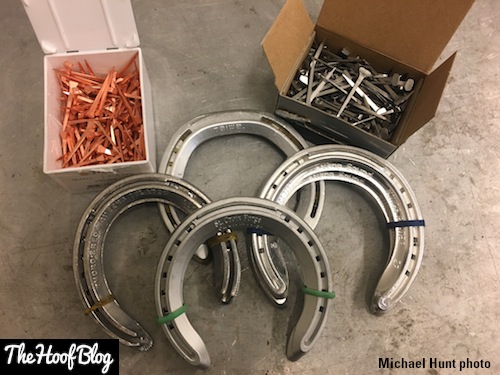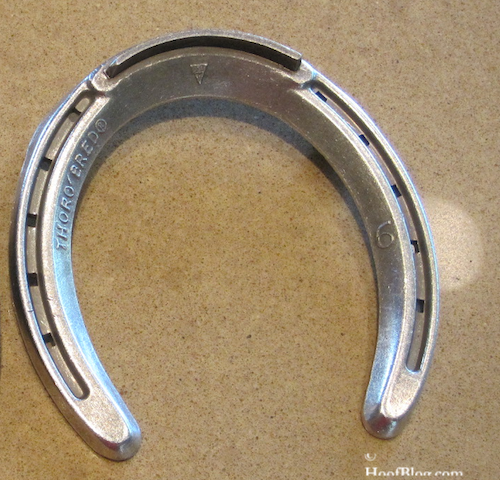A change to how American Thoroughbreds may be shod, including what shoes they can wear, is key to the new rules, limiting the use of shoe traction devices with one national rule for the entire United States.
- If you do not shoe/train/own racehorses, sell racehorse shoes, or manufacture raceplates, this law should not affect you or your business.
- The implementation of this law may create confusion and rumors in the coming months. It's important to know what the rules say -- and do not say.
- In the early days of the commenting process, some confusion existed about traction devices, but that has now been clarified.
- Many state jurisdiction and "house" rules at individual tracks would be superseded by the new policy.
 |
| Dr. Sue Stover, chair of the HISA Racing Safety Committee |
The new HISA rule Thoroughbred racehorse shoes (Rule 2276):
- (a) Except for full rims 2 mm or less from the ground surface of the Horseshoe, traction devices are prohibited on forelimb and hindlimb Horseshoes during racing and training on dirt or synthetic racing tracks.
- (b) Traction devices are prohibited on forelimb and hindlimb Horseshoes during training and racing on the turf.
- (c) Traction devices include but are not limited to rims, toe grabs, bends, jar calks and stickers.
 |
| Raceplates and nails from several international manufacturers used at the Dubai World Cup in past years. (Michael Hunt photo/Hoof Blog archives) |
The Federal Trade Commission admits that the rule had previously allowed toe grabs, but that will no longer be the case. On January 5, 2022, HISA posted in the Federal Register that the language is clarified in this sentence:
Initial draft allowed some usage of toe grabs but, based on significant industry input and considered research and available industry information, ultimately concluded it was prudent and appropriate to totally preclude toe grabs on forelimbs and hind limbs.
 |
| A British racehorse shod with raceplates devoid of added traction. Photo courtesy of Stromsholm Limited, United Kingdom. |
In addition:
“The rule limits the height of rims used as traction devices on forelimb and hindlimb horseshoes. The rule prohibits use of any other traction devices. Traction devices have been thought to increase a horse's ability to “dig in” to the track surface and prevent slipping. Traction devices reduce the horse's ability to plant its hoof properly and move correctly through the surface. That reduction of movement contributes to catastrophic breakdowns and skeletal and muscle-related injuries.
“The rule follows the scientific evidence that shows that traction devices increase equine injuries.
“The rule will standardize traction device use nationwide."
Commentary: While the law allows rim shoes, it certainly does not require them. It also doesn't specify what types of rim shoes, other than maximum rim height.
 |
| A typical American-style toe-clip shoe. Raceplates come in many designs, and toe plates come in different heights. (Hoof Blog file photo) |
In the near future, more information will be provided here for you to read, but it will not change what the rules say or the fact that they have been approved by the FTC and will go into effect on July 1, barring any unforeseen delay by HISA.
More about HISA:
HISA is an Act of Congress. It was signed into law by then-President Donald Trump on December 27, 2020. HISA only has jurisdiction over Thoroughbred horse racing in the United States. Harness racing is not covered by HISA.In its comments log, HISA documented only one stakeholder remark about the new horseshoe rule: “One commentator believes that full rims of 4mm or less should be permitted, in place of the current rule prohibiting the use of rims of 2mm or less,” HISA noted.
The rule change may motivate manufacturers and retailers of race plates to get the word out to their customers and to adjust their inventories.
Link to full documentation of HISA safety rules approved by the FTC on March 4, 2022.
Disclaimer: No one associated with Hoofcare Publishing was involved in writing, setting, or reviewing of the new rules. Hoofcare Publishing was not compensated for publishing this article.
Please check back soon and often for updates on HISA's racing safety governance plans. You might want to sign up for email alerts from Hoofcare Publishing as we move forward on this issue. You can do that by clicking on this link or by sending an email stating that you wish to be added to the alert list to hoofblog (at) gmail.com. |
| Click here to learn more about HoofSearch, the monthly research report on peer-reviewed equine research related to lameness and the horse's foot, including a section on racing safety and injury. |
Questions or problems with this site? Click here to send an email hoofblog@gmail.com.

.png)


